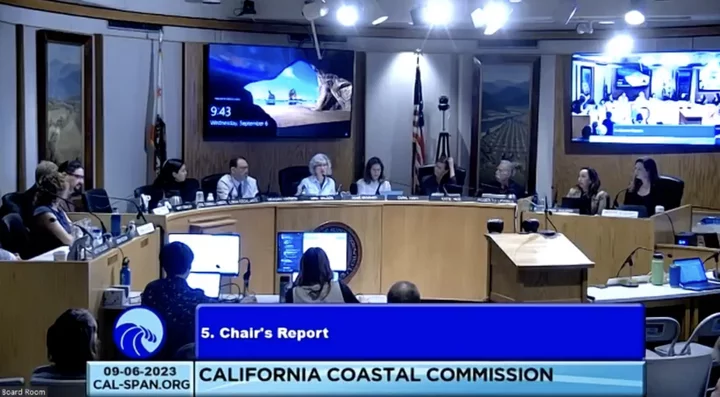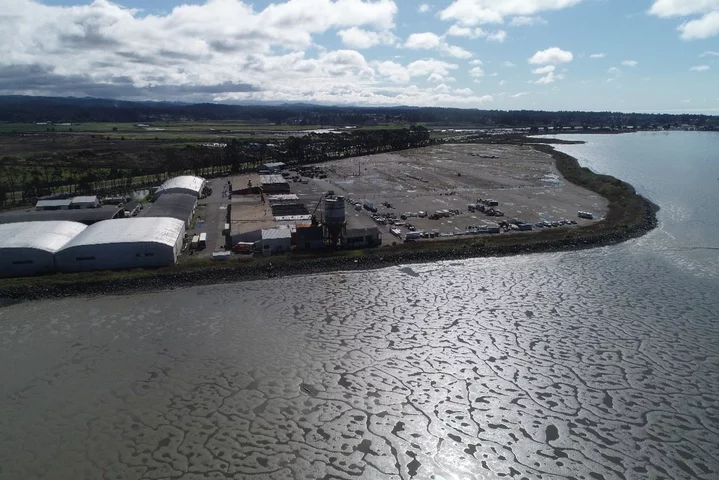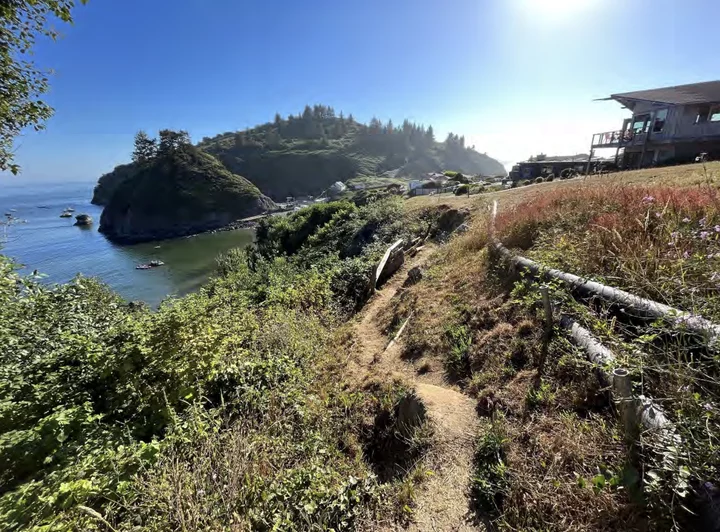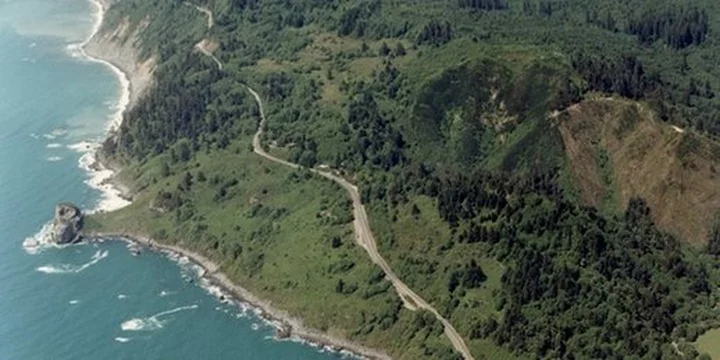Screenshot of Wednesday’s California Coastal Commission meeting in Eureka.
###
Big changes are coming to the old Brainard Mill Site. This week, Sequoia Forest Products LLC — which is in the process of buying the site from the California Redwood Company — got the green light from the California Coastal Commission to revamp the 78-acre property, located along the eastern shoreline of Humboldt Bay across Highway 101 from Mid-City Motor World, to make way for industrial development and manufacturing.
The project proposal includes demolition and removal of 16 industrial buildings, as well as several improvements to the existing lumber mill “for continued use in lumber production as an ultra-high fiber recovery sawmill producing redwood fence boards,” according to the staff report. “Internal modifications are planned within Building FF to support use of the site, including remodeling of a restroom, and the installation of a lunch/break room, a programmable logic control (PLC) room, and small office spaces. These improvements require no additional foundation work or expansion of the building envelope.”
Aerial view of the Brainard site. Image: County of Humboldt
The project will not interfere with the construction of the Humboldt Bay Trail South, which will connect the gap between the Eureka Waterfront Trail and the southern end of Humboldt Bay Trail North, near the Bracut Industrial Park. One of the conditions attached to the application – Special Condition 9 – stipulates that the Coastal Development Permit for the project will “not waive any public rights or interest that exist or may exist on the property or on adjacent public access trails and public waters.”
The Coastal Commission reviewed the Coastal Development Permit application during Wednesday’s meeting, held in the Humboldt County Board of Supervisors Chambers in Eureka.
Before closing out the brief discussion, Commissioner and Humboldt County Third District Supervisor Mike Wilson said he looked forward to seeing the improvements at the new mill site.
“I think there’s some great mural opportunities there,” he added. “Looking forward to the new owner maybe considering that for the future.”
The item was moved to the commission’s consent calendar at the beginning of the meeting and was approved with conditions in a unanimous vote.
Ongoing Closure of Van Wycke Trail
The commission also considered an appeal to a four-year-old decision by the City of Trinidad to temporarily close a 165-foot-long segment of the Van Wycke Trail. The city implemented the six-month closure in January 2019 after reviewing the findings of a risk management assessment report prepared by the city’s insurance provider that found increased erosion had led to unsafe conditions along the trail. Nearly five years later, the trail is still closed to the public.
Close-up of the northeastern part of the Van Wycke Trail Closure taken Aug. 11, 2023. Image: California Coastal Commission
Speaking during Wednesday’s meeting, the appellant, Trinidad resident Kimberly Tays, criticized the city for failing to fix the trail in a timely manner. “We want the trail repaired and reopened so we can continue to enjoy the trail without worries of being harassed, which is what has happened in the past with property owners coming out and chasing people off the trail,” she said.
To avoid the closed section, trail users must deviate from the path and walk along Edwards Street, which, Tays said, can be extremely dangerous for pedestrians.
“Who wants to give up the beautiful coastal trail for a busy road?” she asked. “We have to worry about getting hit and injured – or even killed – by a speeding or distracted driver. … Many of the vehicles on Edwards [Street] are oversized trucks. Studies have shown that pedestrians are more likely to die if struck by a truck.”
Local attorney Bryce Kenny added that the City of Trinidad “has already abused the concept of a temporary closure for over four years.”
“Over four years! That’s not a temporary closure,” he said. “I’m afraid that if the appeal’s not given a hearing, it will be another four years, another temporary closure, and pretty soon nobody [will] even remember there was a trail there.”
Trinidad City Manager Eli Naffah explained that the city tried to find a way to reopen the trail immediately following its closure but was unable to come to a consensus with community members.
“We were able to secure a $700,000-plus grant [from Caltrans] for what was called the ‘Van Wycke [Bicycle and Pedestrian Connectivity] Project’ that … would have made Van Wycke accessible to pedestrians and bicyclists by doing a retaining wall, and then also would have made improvements on Edwards [Street],” Naffah said. “In January 2020, at a council meeting to address this issue, a number of people came and spoke against the project … and a number of them were from either the Tsurai Ancestral Society or from the Yurok Tribe. … They said that they didn’t want the retaining wall because it would be on, I guess, sacred ground.”
The Trinidad City Council agreed to explore alternatives to the retaining wall, Naffah said, but wasn’t able to come to a consensus. Eventually, the city decided to return the grant funds to Caltrans.
Shana Gray, deputy director of statewide planning for the commission, acknowledged the complexity of the issue but spoke in support of staff’s recommendation to find “no substantial issue” and deny the appeal.
“To either open the trail or to formally close the trail [the City of Trinidad] need[s] to come back with an actual permanent action or inaction, something,” she said. “This really is just for the six months from today. … We are recommending no substantial issue in this case.”
Gray added that Edwards Street “is not a comparable alternative” to the Van Wycke Trail. “I don’t want anyone to walk away thinking that’s what we’re saying,” she said
After a bit of additional discussion, Commissioner Roberto Uranga made a motion to approve staff’s recommendation, which was seconded by Commissioner Wilson. The motion passed unanimously.
Last Chance Grade Project Update
The commission also received a brief update on the Last Chance Grade Project in Del Norte County. If everything goes according to plan in the next couple of weeks, Caltrans will be able to open both lanes of Highway 101 at Last Chance Grade, between Klamath and Crescent City, for the first time in nine years.
“While we take a pause on the short-term job, the long-term project continues,” Last Chance Grade Project Manager Jaime Matteoli told commissioners.
Caltrans has sought a permanent fix for Last Chance Grade for years. In recent years, Caltrans has whittled its ideas down to two alternatives: an inland tunnel bypass (Alternative F) and end-to-end re-engineering of the highway (Alternative X).
“Based on criteria that our stakeholders gave us in 2021, we were able to reduce those [options] to focus on the alternatives that were performing the best and using our resources the best way we could. Both those alternatives improve access for cyclists and pedestrians,” Matteoli said. “Next year, we will select the preferred alternative and we begin coordinating with all of the permitting agencies, including Coastal Commission. We expect to apply for a coastal development permit early in the design phase, which would begin in 2026.”
The commission agreed to accept the report but did not take further action on the item.
Aerial view of Last Chance Grade. Image: Caltrans




CLICK TO MANAGE